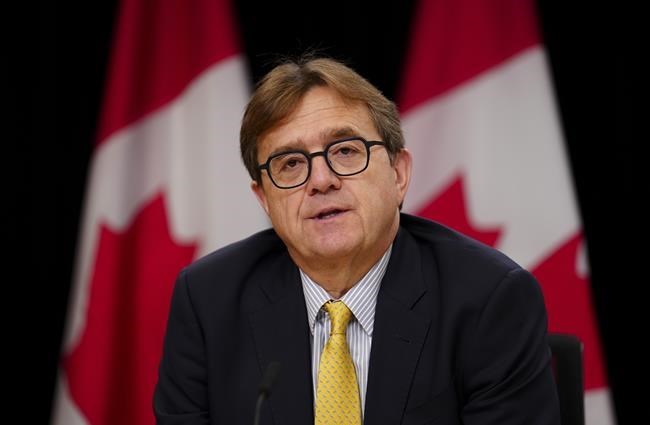OTTAWA — Canada's energy minister is defending carbon capture and storage technology as both effective and affordable, after an Alberta power company walked away from a planned project and a study found that another project got public subsidies to cover more than three-quarters of its costs.
"Carbon capture and sequestration technologies are getting better and, over time, they actually get less expensive just like every other technology that goes through the cycle," Jonathan Wilkinson said Tuesday.
"For those that say that the technology itself is not proven, I'd just say to them that's not true. The technology, the basic technology, has been around for a long time. It's a matter of scale and it's a matter of cost and those are both things that are actually happening."
Carbon capture, utilization and storage, also known as CCUS, are systems that trap carbon emissions at their source and then funnel them back underground. They are expected to play a key role in Canada's climate plan, which cannot meet its targets and continue to produce the oil and gas that underlie a significant portion of Canada's economy.
The climate plan estimates carbon capture will account for up to 16 million tonnes of emissions reductions by 2030, or about five per cent of the additional emissions reductions needed to meet the next target in 2030.
The International Energy Agency expects CCUS will need to account for 15 per cent of global emissions reductions by 2050 to achieve net-zero, where all emissions are eliminated or captured.
"Increased use of CCUS features in the mix of every credible path to achieving net zero by 2050, including all 1.5 C pathways developed by the United Nations Intergovernmental Panel on Climate Change and the (International Energy Agency)," Canada's climate plan reads.
But in Canada, that increased use is proving to be complicated.
The latest national emissions report published last week shows that as of 2022, Canada had captured and stored a total of 7.2 million tonnes of carbon dioxide since 2017, most of it at Shell Canada's Quest CCS facility at its Scotford upgrader north of Edmonton.
Shell covered about three-quarters of the $1.1 billion capital and operating costs for Quest through provincial and federal subsidies, and the rest came from the sale of carbon credits generated through the trapping of carbon emissions.
A Greenpeace study released this week found that to make ends meet, the company got permission from Alberta to sell twice as many credits as it actually earned.
A Shell spokesman said in a statement to The Canadian Press Wednesday that the extra credits were an "innovative mechanism to make investment in the Quest CCS project possible."
However, Stephen Doolan said the double carbon credits were only allowed until project costs broke even and all additional credits Shell earned were used to meet its own emissions requirements in Alberta. They were not sold to any other companies, Doolan said.
Quest has now trapped a total of nine million tonnes of carbon, he said.
"Without the various incentives to make the project investible, this would simply not have happened," he said.
Last week, Capital Power, an Edmonton electricity generator, scrapped a $2.4-billion carbon capture system planned for its Genesee generating station because the economics didn't work. A statement from the company in its quarterly earnings report on May 1 said that while carbon capture is "technically viable" the company did not believe the project to be "economically feasible."
The decision comes even as the Alberta government was promising to cover up to 12 per cent of the costs and the federal government as much as half through a new tax credit.
Additional certainty was being tested with carbon contracts for difference under the new Canada Growth Fund. Such contracts help provide certainty that a carbon market will be robust for credits generated by technology like carbon capture and storage.
The uncertainty over whether the federal carbon price will be maintained by future governments undermines confidence that such markets will exist or that high enough prices will be achieved for the credits. Investments only make sense if companies can get certainty about the price they will be able to sell those credits for.
Capital Power has not yet been able to negotiate a contract for difference.
Wilkinson said the cancellation shouldn't be viewed as a signal against carbon capture.
"There are a number of different pathways for Capital Power to be able to actually meet the requirements of the clean fuel or clean electricity regulations which will eventually come into force," he said.
"They've made a business decision that they can actually meet those requirements in a different way. But as I say, there are going to be many different approaches in different sectors that I believe will use carbon capture technology."
The Alberta government blamed the Capital Power decision on the fact Ottawa hasn't yet put the carbon capture tax credit in place.
The credit was first promised three years ago but took several years to design, and was included in the legislation to implement the fall economic statement in November.
That bill still hasn't passed. It is up for debate again this week.
This report by The Canadian Press was first published May 8, 2024.
Mia Rabson, The Canadian Press



